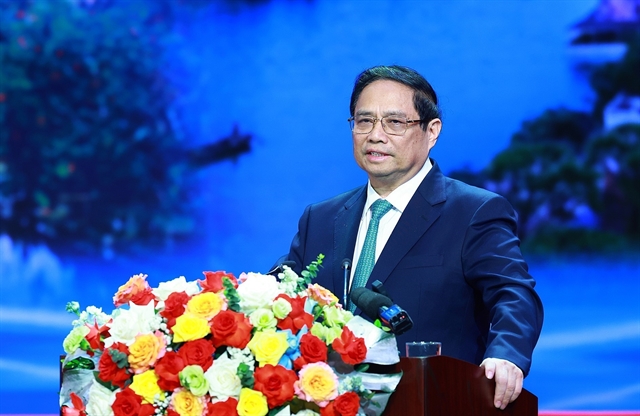 Life & Style
Life & Style

 |
| Prime Minister Phạm Minh Chính delivers his speech at a conference on Ninh Bình Province's Master Plan. — VNA/VNS Photo Dương Giang |
NINH BÌNH — A master plan for Ninh Bình Province, with a vision to 2050, offering new directions, new visions and modern development prospects, has been released.
Prime Minister Phạm Minh Chính today outlined plans for the northern province of Ninh Bình, covering the period until 2030 and then forward for the next two decades, which is expected to provide fresh motivation for the common development of the locality.
The provincial plans embrace a green development model, said PM Chính, based on four key economic sectors and three developmental corridors.
The four are tourism and cultural industry, the automotive and mechanical industry, innovative entrepreneurship and ecological agriculture.
Those three corridors of development are North-South, East-West and coastal areas.
"This is an exceptionally judicious choice, strategically significant and decisively impactful for the rapid and sustainable development of the province in the time ahead," Chính highlighted.
He then told the province to focus on mobilising and efficiently using all legitimate resources to implement the plan, particularly in terms of investing in the local workforce, to become a nexus for the nation's three regions.
Additionally, the province needed to focus on three driving forces, consisting of developing strategic infrastructure, enhancing regional connectivity domestically and internationally; fostering a service industry development, cultural and entertainment industries; and boosting science and technology, innovation, a green and digital economy, and adapting to meet the demands of climate change.
He also urged the province to construct and actively implement the planning needed, maximising internal and external resources, promoting public-private partnerships and attracting investment in strategic infrastructure, particularly in terms of transportation and urban infrastructure, accelerating administrative reforms, improving the investment environment, investing in education and training, as well as developing a quality work force.
The provincial administration must widely disseminate the planning through various means to ensure the public understanding, support, compliance and oversight of the planning implementation.
He ordered ministries and agencies to continue coordinating with the province in deploying the planning according to their functions, tasks and authorities.
He added that the province needed to develop a "smooth infrastructure, intelligent governance and open mechanisms" for rapid and sustainable development of the province.
The business community was ordered to uphold the mission of enterprises with the spirit of "together listening and understanding, together sharing vision and action, and together working, winning, enjoying, and developing."
With the province's historical and cultural traditions, aspirations and pride in its ancient capital, it had the opportunity to create a strong identity, a centrally-run city with a civilised, modern, intelligent, distinctive character, on par with millennium heritage cities and creative cities worldwide, he said.
Automotive mechanical industry hub
Under the provincial plan, by 2030 Ninh Bình needs to meet the criteria of a centrally-run city with the characteristics of an ancient heritage city, a creative city, one of the major centres with high brand value in tourism, cultural industries, one of the major centres of national and Southeast Asian heritage economies.
The province also plans to be a leading modern automotive mechanical industry hub of the nation, creating a cohesive ecosystem of innovative entrepreneurship, ensuring a solid foundation in national defence and security.
Under the plan, the average Gross Regional Domestic Product (GRDP) growth rate for the period 2021-30 of Ninh Bình is forecast to reach 9.2 per cent.
The average per capita GRDP will be about VNĐ200 million (US$7,842); ranking it among the top 10 provinces and cities with the highest average per capita income nationwide.
The economic structure of GRDP will include agriculture-forestry-aquaculture accounting for 5.3 per cent; industry-construction accounting for 45.3 per cent; services accounting for 38.3 per cent.
The poverty rate, according to multidimensional poverty standards, will be below 2 per cent.
Ninh Bình will promote the development of the automotive mechanical industry, high-tech industry, and environmentally friendly industries as the driving force for growth; developing tourism and cultural industries; promoting innovation, administrative reform, digital transformation, building a digital government and comprehensive digital economy; enhancing competitive capacity, improving the investment and business environment; training and developing human resources to meet the demands of socio-economic development in the Fourth Industrial Revolution.
Along with that, the province will make comprehensive development of culture-society; preserving and promoting the good traditional cultural values of the people in the ancient capital area; focusing on preserving, restoring, promoting the heritage of the Citadel of Hoa Lư and the World Cultural and Natural Heritage Site of Tràng An.
Last year, the GRDP growth rate of Ninh Bình reached 7.27 per cent, ranking it eighth in the Red River Delta Region and 22nd nationwide with growth rates still at 8.02 per cent in the first quarter of this year.
Since 2022, the province has autonomously managed its budget, with exports ranking 23rd out of 63 provinces and cities across the country. — VNS




